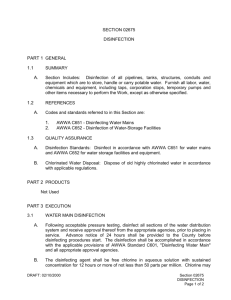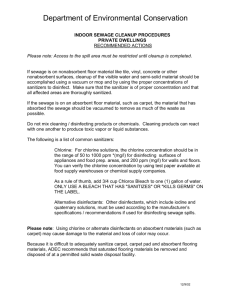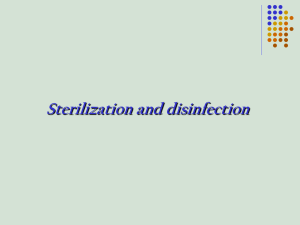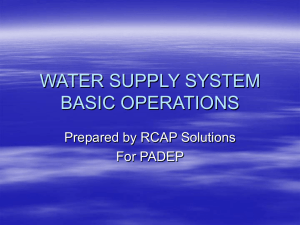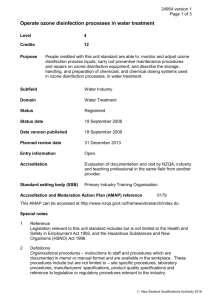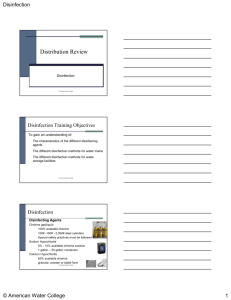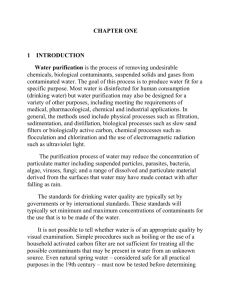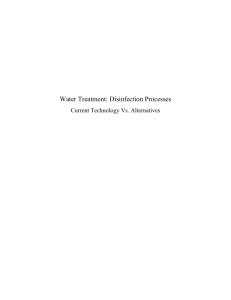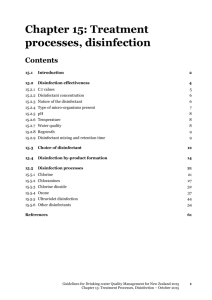Water Recycling at GIT
advertisement
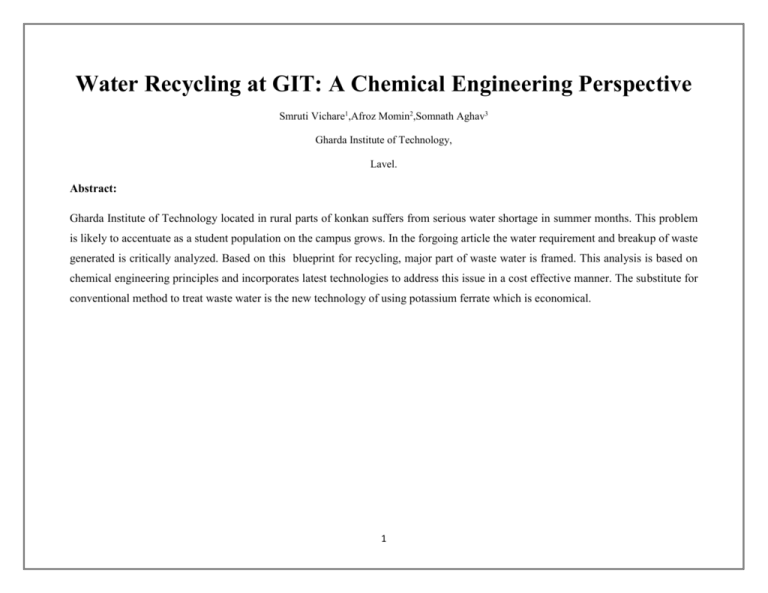
Water Recycling at GIT: A Chemical Engineering Perspective Smruti Vichare1,Afroz Momin2,Somnath Aghav3 Gharda Institute of Technology, Lavel. Abstract: Gharda Institute of Technology located in rural parts of konkan suffers from serious water shortage in summer months. This problem is likely to accentuate as a student population on the campus grows. In the forgoing article the water requirement and breakup of waste generated is critically analyzed. Based on this blueprint for recycling, major part of waste water is framed. This analysis is based on chemical engineering principles and incorporates latest technologies to address this issue in a cost effective manner. The substitute for conventional method to treat waste water is the new technology of using potassium ferrate which is economical. 1 Pattern of water usage: As per WHO standards water requirement per person per day is 130lit-150lit. As per estimation out of 150lit/day, 10lit is used for cooking and drinking which has to be of highest quality, 10lit/day is used for sewage and remaining is used for washing, bathing, and other miscellaneous needs. Basis: 150 liter of water per person per day. Use pattern • Cooking Quality of water Quantity of Quantity of Pollution load water used water rejected Lit/day Lit/day Highest 10 Nil nil Low 10 10 Highest(10% and drinking • Sewage solid) • Washing Moderate 130 130 Low and bathing (0.5% solid) Table:1 The present practices the sewage is combined with washing and bathing water which after treatment in septic tank is used for agriculture. This is against established chemical engineering principles, the pollution has to be treated at the source. 2 The present practice world over is, first we allow the polluted water to be mixed with large body of good quality water like rivers, lakes, seas and try to take care of water pollution by dilution at subsequent natural processes. As against this, the best approach would be to segregate waste water streams on the basis of pollutant load and each stream be treated separately and then put to best possible use. This approach will reduce the energy and efforts involved in the treatment at least possible cost. Their are step wise procedure for the treatment of waste water, which is as follows: Pre-treatment: Pre-treatment removes materials that can be easily collected from the raw waste water before they damage or clog the pumps and skimmers of primary treatment clarifiers. Screening: The influent waste water is screened to remove all large objects carried in the waste water stream. This is most commonly done with an automated mechanically raked bar screen in modern plants serving large populations, whilst in smaller or less modern plants a manually cleaned screen may be used. The raking action of a mechanical bar screen is typically paced according to the accumulation on the bar screens and/or flow rate. The solids are collected and later disposed in a landfill or incinerated. Bar screens or mesh screens of varying sizes may be used to optimize solids removal. If gross solids are not removed they become entrained in pipes and moving parts of the treatment plant and can cause substantial damage and inefficiency in the process. Grit removal: Pre-treatment may include a sand or grit channel or chamber where the velocity of the incoming wastewater is adjusted to allow the settlement of sand, grit, stones, and broken glass. These particles are removed because they may damage pumps and other equipment. For small sanitary sewer systems, the grit chambers may not be necessary, but grit removal is desirable at larger plants. 3 Primary treatment: In the primary sedimentation stage, sewage flows through large tanks, commonly called "primary clarifiers" or "primary sedimentation tanks." The tanks are used to settle sludge while grease and oils rise to the surface and are skimmed off. The dimensions of the tank should be designed to effect removal of a high percentage of the floatables and sludge. A typical sedimentation tank may remove from 60 to 65 percent of suspended solids, and from 30 to 35 percent of biochemical oxygen demand (BOD) from the sewage. Secondary treatment: Filter beds (oxidizing beds): Trickling Filter In older plants and those receiving variable loadings, Trickling Filter beds are used where the settled sewage liquor is spread onto the surface of a bed made up of coke (carbonized coal), limestone chips or specially fabricated plastic media. Such media must have large surface areas to support the biofilms that form. The liquor is typically distributed through perforated spray arms. The distributed liquor trickles through the bed and is collected in drains at the base. These drains also provide a source of air which percolates up through the bed, keeping it aerobic. Biological films of bacteria, protozoa and fungi form on the media’s surfaces and eat or otherwise reduce the organic content. This biofilm is often grazed by insect larvae, snails, and worms which help maintain an optimal thickness. Overloading of beds increases the thickness of the film leading to clogging of the filter media and ponding on the surface. Recent advances in media and process micro-biology design overcome many issues with Trickling filter designs. 4 Tertiary treatment The purpose of tertiary treatment is to provide a final treatment stage to raise the effluent quality before it is discharged to the receiving environment (sea, river, lake, ground, etc.). More than one tertiary treatment process may be used at any treatment plant. If disinfection is practiced, it is always the final process. It is also called "effluent polishing." Filtration: Sand Filtration removes much of the residual suspended matter. Filtration over activated carbon, also called carbon adsorption, removes residual toxins. Lagooning: Lagooning provides settlement and further biological improvement through storage in large man-made ponds or lagoons. These lagoons are highly aerobic and colonization by native macrophytes, especially reeds, is often encouraged. Small filter feeding invertebrates such as Daphnia and species of Rotifera greatly assist in treatment by removing fine particulates. Disinfection: The purpose of disinfection in the treatment of waste water is to substantially reduce the number of microorganisms in the water to be discharged back into the environment. The effectiveness of disinfection depends on the quality of the water being treated (e.g., cloudiness, pH, etc.), the type of disinfection being used, the disinfectant dosage (concentration and time), and other environmental variables. Cloudy water will be treated less successfully, since solid matter can shield organisms, especially from ultraviolet light or if contact times are low. 5 Generally, short contact times, low doses and high flows all militate against effective disinfection. Common methods of disinfection include ozone, chlorine, ultraviolet light, or sodium hypochlorite. Chloramine, which is used for drinking water, is not used in waste water treatment because of its persistence. Chlorination remains the most common form of waste water disinfection in North America due to its low cost and long-term history of effectiveness. One disadvantage is that chlorination of residual organic material can generate chlorinated-organic compounds that may be carcinogenic or harmful to the environment. Residual chlorine or chloramines may also be capable of chlorinating organic material in the natural aquatic environment. Further, because residual chlorine is toxic to aquatic species, the treated effluent must also be chemically dechlorinated, adding to the complexity and cost of treatment. Ultraviolet (UV) light can be used instead of chlorine, iodine, or other chemicals. Because no chemicals are used, the treated water has no adverse effect on organisms that later consume it, as may be the case with other methods. UV radiation causes damage to the genetic structure of bacteria, viruses, and other pathogens, making them incapable of reproduction. The key disadvantages of UV disinfection are the need for frequent lamp maintenance and replacement and the need for a highly treated effluent to ensure that the target microorganisms are not shielded from the UV radiation (i.e., any solids present in the treated effluent may protect microorganisms from the UV light). In the United Kingdom, UV light is becoming the most common means of disinfection because of the concerns about the impacts of chlorine in chlorinating residual organics in the wastewater and in chlorinating organics in the receiving water. Some sewage treatment systems in Canada and the US also use UV light for their effluent water disinfection. Ozone (O3) is generated by passing oxygen (O2) through a high voltage potential resulting in a third oxygen atom becoming attached and forming O3. Ozone is very unstable and reactive and oxidizes most organic material it comes in contact with, thereby destroying many pathogenic microorganisms. Ozone is considered to be safer than chlorine because, unlike chlorine which has to be stored on site (highly poisonous in the event of an accidental release), ozone is generated onsite as needed. Ozonation also produces fewer disinfection by-products than chlorination. A disadvantage of ozone disinfection is the high cost of the ozone generation equipment and the requirements for special operators. 6 Odour Control: Odours emitted by sewage treatment are typically an indication of an anaerobic or "septic" condition. Early stages of processing will tend to produce smelly gases, with hydrogen sulfide being most common in generating complaints. Large process plants in urban areas will often treat the odours with carbon reactors, a contact media with bio-slimes, small doses of chlorine, or circulating fluids to biologically capture and metabolize the obnoxious gases. Other methods of odour control exist, including addition of iron salts, hydrogen peroxide, calcium nitrate, etc. to manage hydrogen sulfide. 7 Conclusion: As the chemical engineering principle is to treat the pollution at the cause but the conventional method used is diluting the waste water by collecting it the from sewage , washing , bathing, etc. into fresh water bodies and then treating it to remove the impurities. In GIT also the municipal method of collecting the waste water from sewage, washing, bathing is observed. But instead, if we collect the waste water from washing and bathing in different tank and further treated would reduce the problems faced by GIT in summers. The water after treatment can even be used for drinking if reverse osmosis is carried out on the waste water. Or otherwise, the water can be used for car washing, bathing, etc. The conventional method is so time consuming and many processes has to be carried out to purify the water. Instead a new technique is developed using Potassium Ferrate to treat the water which is obtained after pre-treatment. This is a compound which removes all the impurities from water and forms precipitate of iron. This is a new method which should be known to every one of us, as a Chemical Engineer! 8 References: 1. Specialty chemicals in the environment , A.T.Stone, march 2000. 9 7 10


